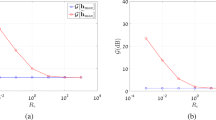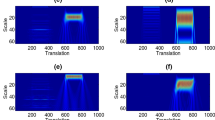Abstract
Signal-to-noise ratio (SNR) is an essential concept or quantity on the result of a process or on the output of a filter, which helps us in designing, analyzing or evaluating a system. In this paper, we study SNR for bilinear time–frequency transform (TFT). Firstly, according to the definition of SNR in time domain, we define a proper form for SNR in time–frequency (T–F) plane for bilinear TFT; then, we extract SNR relation in terms of TFT kernel, signals power and noise power in time domain. The extracted relation of SNR for bilinear TFT that can be represented in terms of Wigner–Ville distribution (WVD) shows its dependence on the kernel used in the TFT. Finally, to illustrate the applicability of the proposed SNR, the relations of SNR for several distributions are extracted in the T–F domain, and the variation of SNR versus the noise variance is shown by curves. The results show that the WVD has higher SNR than the Rihaczek, Page, spectrogram and Levin respectively.



Similar content being viewed by others
Notes
As an important example, for Wigner-Ville distribution that \( G\left( {t,\tau } \right) = \delta \left( t \right),{\text{we}}\;{\text{have}}\;R_{xx}^{G} \left( {t + \frac{\tau }{2},t - \frac{\tau }{2}} \right) = R_{xx} \left( {t + \frac{\tau }{2},t - \frac{\tau }{2}} \right) \).
References
Chen, V.C.: Radar ambiguity function, time-varying matched filter, and optimal wavelet correlator. Opt. Eng. 33(7), 2212–2217 (1994)
Chen, V.C.: Reconstruction of inverse synthetic aperture radar image using adaptive time–frequency wavelet transform (invited paper). SPIE Proc. Wavelet Appl. 2491, 373–386 (1995)
Djurović, I.: Estimation of sinusoidal frequency-modulated signal parameters in high-noise environment. SIViP 11(8), 1537–1541 (2017)
Gulum, T., Yildirim, A.E., Kata, L.: Parameter extraction of FMCW modulated radar signals using wigner-hough transform. IEEE Int. Symp. Comput. Intell. Inform. 12, 465–468 (2011)
Khan, A.N., Mohammadi, M., Ali, S.: ‘Instantaneous frequency estimation of intersecting and close multi-component signals with varying amplitudes. Signal, Image Video Process. 13(3), 517–524 (2018)
Arivazhagan, S., Ganesan, L., Subash Kumar, T.G.: A modified statistical approach for image fusion using wavelet transform. SIViP 3, 137–144 (2009)
Pitton, J., Wang, K., Juang, B.: Time-frequency analysis and auditory modeling for automatic recognition of speech. In: Proceedings of IEEE, Special Issue on Time–Frequency Analysis, Sept. (1996)
Zeng, D., Zeng, X., Lu, G., Tang, B.: Automatic modulation classification of radar signals using the generalised time-frequency representation of Zhao, Atlas and Marks. IET Radar. Sonar Navig. 5(4), 507–516 (2010)
Das, A.B., Bhuiyan, M.H., Alam, S.M.S.: Classification of EEG signals using normal inverse Gaussian parameters in the dual-tree complex wavelet transform domain for seizure detection. SIViP 10(2), 259–266 (2016)
Xia, X.: A Quantitative Analysis of SNR in the short-time Fourier transform domain for multicomponent signals. IEEE Trans. Signal Process. 46(1), 200–203 (1998)
Xia, X., Chen, V.C.: A quantitative SNR analysis for the pseudo Wigner–Ville distribution. IEEE Trans. Signal Process. 47(10), 2891–2894 (1999)
Bi, G., Li, X., See, C.S.: LFM signal detection using LPP-Hough transform. J BV 91, 1432–1443 (2011)
Zhao, Y., Liu, Y., Li, X., Jiang, N.: “Time–frequency domain SNR estimation and its application in seismic data”, processing. J. Appl. Geophys. 107, 25–35 (2014)
Xia, X.G., Wang, G., Chen, V.C.: Quantitative SNR analysis for ISAR imaging using joint time-frequency analysis-Short time Fourier transform. IEEE Trans. Aerosp. Electron. Syst. 38(2), 649–659 (2002)
Zhang, Y.-N., Li, B.-Z., Goel, N.: Quantitative SNR analysis of QFM signals in the LPFT domain with Gaussian windows. Sci. China Inf. Sci. 62, 2 (2018)
Xia, X.G., Wang, G., Chen, V.C.: ‘A quantitative SNR analysis of linear chirps in the continuous-time short-time Fourier transform domain with Gaussian windows. In: IEEE International Conference on Acoustics, Speech, and Signal Processing. Proceedings (Cat. No.01CH37221), Salt Lake City, UT, USA, 6, pp. 3573–3576 (2001)
Boashash, B.: Time-frequency signal analysis and processing. Eurasip and Academic Press Series in Signal and Image Processing, ch.2 (2003)
Grochenig, K.: Foundations of time–frequency analysis, vol. 4. Springer, Berlin (2001)
Seddighi, Z.: Extracting discriminant features from radar signals in IF band and classification radars data using these features. Thesis, Isfahan University of Technology (2018)
Author information
Authors and Affiliations
Corresponding author
Ethics declarations
Conflict of interest
The authors declare that they have no conflict of interest.
Additional information
Publisher's Note
Springer Nature remains neutral with regard to jurisdictional claims in published maps and institutional affiliations.
Appendix
Appendix
For a bilinear TFD of a signal as \( \rho_{s} \left( {t,f} \right) \), we can write as
As \( \mathop \int \limits_{ - \infty }^{\infty } W_{s} \left( {t,f} \right) df = \left| {s\left( t \right)} \right|^{2} \)
and with changing the variables, we have
Rights and permissions
About this article
Cite this article
Seddighi, Z., Ahmadzadeh, M.R. & Taban, M.R. Quantitative analysis of SNR in bilinear time frequency domain. SIViP 14, 1583–1590 (2020). https://doi.org/10.1007/s11760-020-01702-7
Received:
Revised:
Accepted:
Published:
Issue Date:
DOI: https://doi.org/10.1007/s11760-020-01702-7




